|
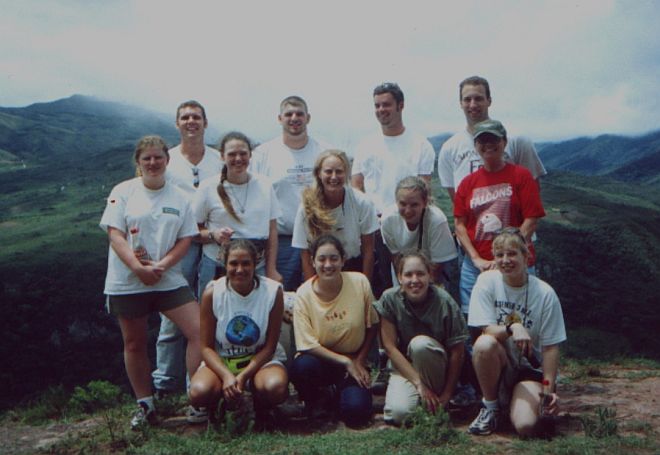
Group Members
Back Row
- Brent Gillette, Ben Davenport, Darren Christopher, Matt Sturgell
Middle Row - Shanti Franklin-Owens, Theresa Moore, Linda Phillips (Professor), Brandy
Bryan, Sandy Stankevich
Front Row - Nicky Peterson, Casey Hulway, Julie Zimmerman, Jennifer Randall
What is this
project really all about? READ ON !!
How
did this project get started?
One of our civil engineering professors, Linda Phillips, presented us
with the possibility of going to an underdeveloped area to volunteer on
a construction site for our senior design project. This kind of project
has never really been explored at Michigan Tech so it will be a learning
experience for all involved. Enough people were willing to give this a
try so it was taken to the board for approval. Once approved, it was decided
that the best location would be Santa Cruz, Bolivia since Linda already
had connections there with people planning to build a school who could
use our help.
What
is the focus of the project?
A group of students chose to embark on a trip
to Santa CruzBolivia with the objective of completing their senior design
project. Thiswas merely the beginning of an adventure that would broaden
their horizons, inspire personal growth and reflection and introduce them
to a culture that is different from anything that they had ever experienced.
This trip was to become a part of the college experience never to be forgotten.
The trip to Bolivia enabled college students
to help a growingcommunity in a developing nation and learn new techniques
of construction in an environment that was much different than the United
States. The construction of a building on a small grade school campus required
creativity, adaptation and patience, among many other things. It has often
been said that volunteering not only helps the cause that is being contributed
to, but brings a sense of personal gratification and accomplishment. In
the case of the project in Santa Cruz, this was the case. The group of
Michigan Technological University students were able to help
construct a brick building and learn about construction, leadership
and working as a team.
Another of the goals of the project was to be able to
see the building first hand and help the community with a flooding problem
that they were experiencing. The students were able to use their civil
and environmental engineering background to design a system that would
help divert and store the run-off from the surrounding area. This required
surveying, research, and communication in order to put together several
options as to how to deal with the excessive run-off.
Santa
Cruz, Bolivia - The Community of Lost Pinos Barrio

Los Pinos Barrio is on of the areas that the Santa Cruz mayor’s
officehad pointed out as the place where many children drop out of school,
leave their families to work on the street. In many cases, they become
street kids with no connection to their families, no education and are
on drugs. This was an area that the church wanted to work to try
to keep the families together,keep kids in school and out of the drug scene.
Nueva Vida Methodist church (associated with the John Wesley school)
began working in the Los Pinos barrio about December 1994 with vacation
Bible school. At the same time they did a survey of the community
asking what the needs were. The most important need was for a kindergarten.
The government had changed the law and required kinder before a child could
enter first grade. There were no kinders close by. A mother
would need to ride a communitybus with her young child to a school and
back home…then repeat the processto pick up the child.
The mothers didn’t have time or money forthis, so children simply
did not attend school. In 1998, they began a kindergartenwith 14 students
enrolled but the first day only 7 kids showed up! Itrained and the
small building that they were using flooded out. The MennoniteCentral
Committee let the church use their facility for the first three weeksof
school. By the end of the first week, there was 39 students enrolled in
their kindergarten.
In June 1998, the church began building an elementary school on the
property that they bought from the Mennonite Central Committee. The
foundations are built for two story buildings although only the first story
was built originally. With the help of teams from Greensboro, NC,
Manitowoc, WI, Michigan and Cincinnati/Dayton, they were able to build
two large classrooms and a set of bathrooms for the school. In 1999,
they had a team from Ohio that built another classroom and an office, making
it possible for the church to offer kinder through fifth grade.
In June and July 2000, teams from Onalaska, WI, Greensboro, NC and Ohio
built the first of the classrooms on the second floor and a storage/library
plus a kiosk under the stairway to the second floor.
As part of Methodist Educational Services, the new elementary school
was recently named Colegio Esther Arias. Ester was the wife of the
First bishop of the Bolivian Methodist Church and was very active in Christian
education and in the development of a child feeding/tutoring and health
care program for low income children in both urban and rural areas.
All the construction is of open face brick with cement columns and cement
floor. The second floor classrooms have time floors. The roof
is of DURALIT, which is a cement fiber tile. There are 3 bathrooms
for girls, 2 bathrooms and a shower for boys, 1 bathroom for the kindergarten
and 1 for the teachers.
In January 2001, MTU students began working on the church sanctuary.
It was also made from open face brick. The two side walls of the
sanctuary were completely finished. There were eight columns poured
and also fill was placed and compacted for the concrete floor.
Any funds or donations would go to provide building materials to be
able to continue the construction of the church/community building. Some
of the material may include the roof, floors, windows, doors, protectors,
glass, etc. You can contact Susie Henry at henry@mail.scbbs-bo.com
- Written by Susie Henry
What did we
actually do?
We
went down there not really knowing what we would be working on. We
knew that it would either be continuing construction on the community/school
or beginning construction on the sanctuary of the church. It turned
out that they had finished the school and the construction had started
on the church.
There were four local construction workers hired by the church to help
with the job. They had already poured the foundation and finished
four of the columns. Our first day on the job was to haul bricks
to the side of the foundation for the start of the brick walls. The
hired hands showed us the ins and outs to laying bricks.
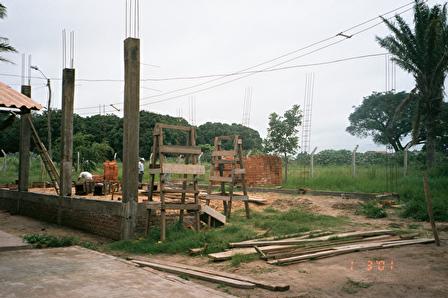
As the days progressed, the wall got higher and higher. Before
long we needed some scaffolding. The scaffolding was made from
scrap lumber and ladders, but it did its job. The large gaps
in the bricks are doors and windows. There was also rebar sticking
out of the columns to tieinto the brick walls. The rebar was laid
flat and the bricks and mortarwere placed on top of it.

While the girls were high up on the scaffolding, the boys were busy
hauling concrete to pour the rest of the columns. They had an assembly
line to make the process go by faster. They would hand the buckets
up one by one and the guy at the top would pour it in. They continued
this process until the entire column mold was filled.

As the days progressed, the walls got higher and more columns were
poured. Some fill had been dumped at the site, so one of the mornings
was spent hauling the fill around the site and compacting it with home
made compactors.
In the mean time, two students from our group (Jennifer and Brent) began
to survey the land. There is a very bad flood problem in the area
and the new site for the next classrooms for the school has been flooded
out many times. Jennifer and Brent used a make shift rod and an old
transit to do the survey. From there they were able to get the elevation
of the land and make a topographicgraph from the information.
The week came to an end and we didn’t have much time left.
The second wall was finished on our last day there. We had
accomplished a lot!
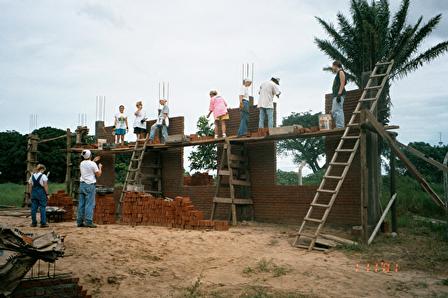
Meeting People
This part of the trip was by far the most memorable. Even though
there was a language barrier we made friendships that will never be forgotten
and learned as much as we could in a short time about their culture.
The first day we arrived in Bolivia we were invited for snacks at the
school where we would be working. Some of the school children had
also prepared a welcoming song and dance for us. We had no idea that
we were going to havesuch a warm welcome from the community. After
we unpacked our things andrested from the trip for a bit we got right to
work. We met the men we wouldbe working with; Mario, Vincente, Elias,
and Don Ari. At first it was alittle hard to try and figure out what
they wanted each of us to do but soonwe got a system working and pretty
much stayed with it for the remainder ofthe time there. The language
barrier never seemed to cause many problems. There were a few people
in the group that could speak Spanish very well sowe were fortunate.
What we didn’t know in Spanish, or they didn’t know
inEnglish, we used hand motions and pointed to things to get our ideas
across. We worked very effectively together. We ate almost
all of our meals withthese men and became very good friends with them.
We started joking on thejob and at meals.
After we had been in Bolivia for a few days we were invited to a game
night with some of the students from around the area. Many of them
were the same age as us and also attending college. We played games
that got us more acquainted and comfortable around each other. We
have to admit that they did everything in their power to welcome us, try
to make friends, and make us feel at home. Another night we invited
them to where we were staying and we all played card games. It was
more fun than any of us imagined!
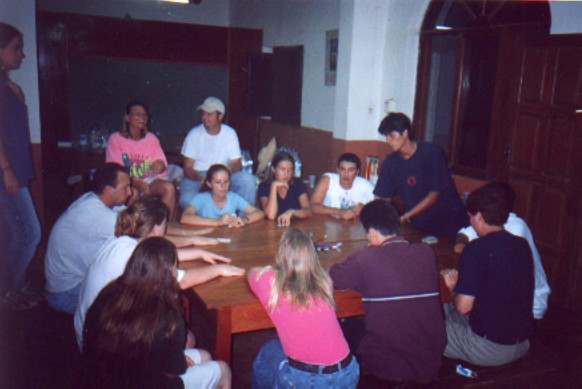
We also had the opportunity to attend dinner in groups of three
at some of the families houses. This is when we really got to see
how they lived and talk more about their families and what they did.
This was a very eye opening experience. In most cases it was not
just one family that attended the meal. The whole neighborhood wanted
to see what was going on and what we were like so they came around too.
All this made the day we would go home even harder. On the last
day we were in Bolivia the men we worked with bought each of us a present.
We had never expected anything like this. It brought tears to all
our eyes. That last night was also very special. The community
members also bought each of us a special gift and presented it to us at
a going away party. The Students and Women from the community did
their cultural dances in all the fancy attire. It was truly amazing
to watch. Saying good bye to all these people that night was one
of the saddest things some of us have ever had to do

.
Memories on this trip were made from the people we met. They
are very special and will never be forgotten.
Traveling
the Countryside
On the weekend that the we were in Bolivia, we were able
to travel into themountains and visit a town called Samaipata. The first
stop on the weekendtrip was the Fort of Samaipata. This is an old Aztec
town that is set at the top of a mountain and has only been restored and
protected in the last ten years. The ruins are still in amazing condition
and several foundations and some walls of homes are still visible.
The view from the ruins is incredible. From the top of the mountain,
it is possible to spot villages in the valleys and agricultural fields
spread over the hills. Samaipata is on the border of the rain forest and
the land is verylush and green. From the top, the winding road can be seen
and it is hard to believe where you must travel in order to reach the top.
On the Sunday of the weekend trip, we traveled to a cloud forest, which
is a kind of rain forest. This rain forest is high up in the mountains
and the ferns that grow there get there water from the moisture in the
air. Therain forest is called a giant fern forest and looking at the ferns
it is understandable that this is its name. The fern are as large as a
grown tree and the fronds are enormous. The forest is the habitat for a
wide variety of wildlife, including monkeys and parrots.
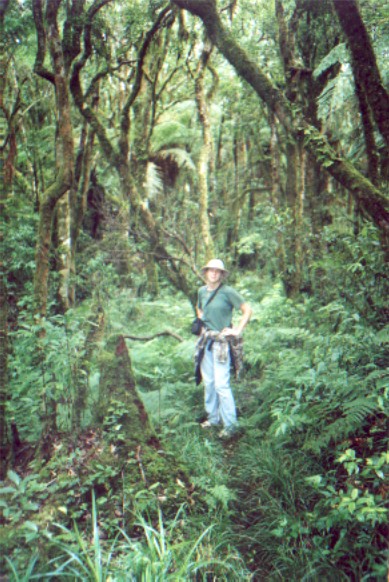 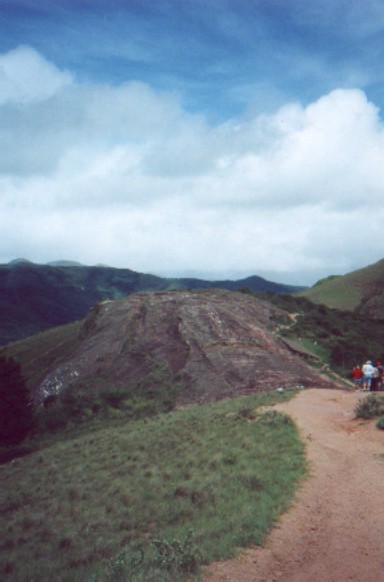
The trail was slippery in the forest, as there is always
moisture in theair and it seems that nothing stays dry for long. The hike
was not easy, butwas worth the views and the experience. From the top of
this mountain, thefog was so thick, that it was not possible for the us
to see more than 20’in front them. Again, it was obvious that
this was a cloud rain forest.
The weekend was a success and contributed greatly to the experience
of the trip. We were able to see the sites and meet more people.
It helped to betterdefine the country that is Bolivia.
Preparing
for the Trip
For most of the group members the trip to Bolivia took a lot of preparation.
Of coarse there are always the spontaneous people in a group who like to
wait till the last minute and do everything-but that doesn’t
work for all of us. The first and most important thing we had to
do was make sure we had enough money to pay for the trip. This included
our plane fare,the class itself, and the lab fees which would be used to
buy some of the materials for building. The next step was to get
the whole group together for aninformational meeting with Jim Cross.
Jim is the director of study abroadand had some very helpful information
to give us. Of coarse there werea lot of forms to fill out, but we
also talked about any fears or concerns we had. Jim and Linda both
explained a little bit of what the culture and people of Bolivia were like
and some things that we should expect. We talked about what we could eat
and what we should stay away from, the necessary vaccinations,and how to
be safe while in a foreign country. All of this was very beneficialbecause
none of us had ever been to Bolivia before. We were also informedof some
of the important things we should bring with us and how much extra moneywould
be appropriate. The last thing we did at this meeting was decideto
setup a class list so when anyone had a question or some information to
share the whole group would be informed.
Getting
To Know Each Other...
Although all the members of this group are civil and/or environmental
engineers, there was not one person in the whole group who knew everybody.
Actually, there were many of us who had never met before. This being
the case, we decided to start having group meetings mostly just so we could
get acquainted with everyone. We would be spending a lot of time
together very soon and we all wanted to make sure there wouldn’t
be any differences between us that would keep the group from having a good
time. We had meetings away from school, in a more laid back atmosphere
so we could just relax, talk with everyone, and have a good time.
We went to other group members houses, went bowling, and went out for pizza.
Not everyone was always able to attend every meeting because of our different
schedules but we all did our best. Although everyone got along very
well it was still a good thing to do because it made us just that much
closer when we got to Bolivia,and made working together easier. These
meetings also gave us a chanceto talk once again about any concerns we
had, what we had discovered in ourindividual research of the country, ideas
for our design project, and whatwe were expecting when we would arrive.
Individual
Research
Each of the group members did their own background research on Bolivia
depending on what they felt was necessary. Some of us were interested
to find out how the people lived, what kinds of food they ate, what the
climate would be like while we were there, and what, if anything, we had
to be careful or cautious of.
Precautions
As with traveling to any foreign country there were many precautions
to be aware of for our trip such as vaccines, the food that you eat, water
you drink,and how to protect yourself and your money.
The most important vaccination to get was for Hepatitis. Bolivia
is a poor country and diseases are prevalent here. Other vaccinations
that members of the group had were for Typhoid Fever, Yellow Fever, Tetanus,
and pills for Malaria. Yellow Fever and Malaria are both to protect
from mosquitos that carry disease and is most needed in urban areas. Since
we spent most of our time in the city it was not mandatory but just a preventative
measure. Typhoid is a disease that is contracted from eating foods
thatare not prepared well or from water that is contaminated. Most people
did not receive this vaccine either because all our food was prepared with
strict guidelines and we drank bottled water, but it was an option. Allthe
fruits and vegetables we consumed had to be washed and peeled before we
could eat them. We could not brush our teeth with the running water, even
though it would not be swallowed. We used bottled water that had
been trucked in especially for our consumption.
We also had to be cautious of our money and possessions we had when
we went into the city. We brought copies of our passports in case
they were stolen and locked them in a safe with any extra money we had.
Any money that we would be using we had in a money belt that was worn under
our clothes and out of sight. This is also where we carried our passport.
Our passports had to be with us at all times. Another copy of our
passports was also left at home with family. Whenever we went into
the city, or just about anywhere, we traveled in groups. There was
always one guy in each group and usually one person who could at least
speak a little bit of Spanish. It was important not to draw attention
to ourselves so allvaluables such as jewelry and designer clothes were
left at home.
It is important to note that no body was harmed or victimized in any
way while on the trip, and I don't think anyone ever felt they were in
danger,except for maybe when we were in taxis who disobey all driving
rules, but it doesn't mean it could not happen as it could anywhere.
First Michigan Tech class to Bolivia Jan
2001
Authors of this web page: Brandy Bryan, Shanti Franklin-Owens,
JulieZimmerman
|

